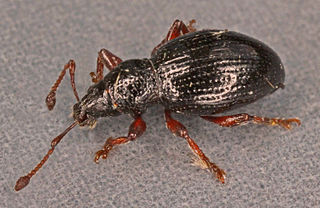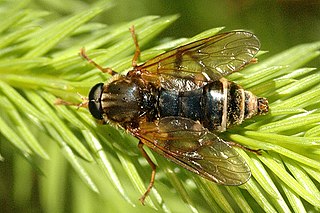
The Curculionidae are a family of weevils, commonly called snout beetles or true weevils. They are one of the largest animal families, with 6,800 genera and 83,000 species described worldwide. They are the sister group to the family Brentidae.

The boll weevil is a beetle that feeds on cotton buds and flowers. Thought to be native to Central Mexico, it migrated into the United States from Mexico in the late 19th century and had infested all U.S. cotton-growing areas by the 1920s, devastating the industry and the people working in the American South. During the late 20th century, it became a serious pest in South America as well. Since 1978, the Boll Weevil Eradication Program in the U.S. allowed full-scale cultivation to resume in many regions.

Weevils are beetles belonging to the superfamily Curculionoidea, known for their elongated snouts. They are usually small, less than 6 mm in length, and herbivorous. Approximately 97,000 species of weevils are known. They belong to several families, with most of them in the family Curculionidae. It also includes bark beetles, which while morphologically dissimilar to other weevils in lacking the distinctive snout, is a subfamily of Curculionidae. Some other beetles, although not closely related, bear the name "weevil", such as the biscuit weevil, which belongs to the family Ptinidae.

The family Gryllidae contains the subfamilies and genera which entomologists now term true crickets. Having long, whip-like antennae, they belong to the Orthopteran suborder Ensifera, which has been greatly reduced in the last 100 years : taxa such as the spider-crickets and allies, sword-tail crickets, wood or ground crickets and scaly crickets have been elevated to family level. The type genus is Gryllus and the first use of the family name "Gryllidae" was by Walker.

Dr Wilhelm Ferdinand Erichson was a trained medical doctor and a German entomologist.

Georg Wolfgang Franz Panzer was a German botanist and entomologist.
Johann Nepomuk von Laicharting was an Austrian entomologist. He was born in Innsbruck on 4 February 1754 and died in the same city on 7 May 1797, and was a Professor of Natural Science (Naturgeschichte) in Innsbruck. He described new species and genera of Coleoptera in Verzeichniss und Beschreibung der Tyroler-Insecten. 1. Teil. Kaferartige Insecten. 1. Band. 1781: I-XII, 1-248. - Zurich, bey Johann Casper Fuessly 1781. In English, lists and descriptions of Tyrol insects - beetles. Presumably this was intended to cover all Austrian insects but no further parts were published.

Johann Kaspar Füssli, also written Johann Caspar Fuesslins or Fuessly, was a Swiss painter, entomologist and publisher.

Hylobius is a genus of true weevils. Several Hylobius species are major pests of coniferous trees.
Johan Adam Pollich or Johann was a German doctor, botanist and entomologist.

Larinus is a genus of true weevils, comprising about 180 species, mostly in the Palaearctic region. Turkey appears to have a significant diversity of the group, with more than 50 species recorded in the Eastern part of the country.

Atherix is a genus of 'ibis flies' belonging to the family Athericidae, a small family very similar to the Rhagionidae. Species within this genus are present in most of Europe and also in the Nearctic realm.

Barypeithes araneiformis is a species of weevil native to Europe.

Dorytomus taeniatus is a species of weevil native to Europe. It was first described by Johann Christian Fabricius in 1781. The larvae cause a small growth on the catkins of willows.

Bodiloides ictericus is a species of dung beetle in the family Scarabaeidae, found in the Palearctic. It is one of more than 50 species in the genus Bodiloides.

Coenomyia ferruginea is a species of fly in the family Xylophagidae.

Rhynchites is a genus of leaf and bud weevils in the family of beetles known as Attelabidae.
Mimosestes is a genus of pea and bean weevils in the beetle family Chrysomelidae. There are about 13 described species in Mimosestes.

Stephanocleonus is a genus of cylindrical weevils in the beetle family Curculionidae. There are at least 70 described species in Stephanocleonus.

Gryllini is a tribe of crickets and typical of the family Gryllidae. Species are terrestrial, carnivorous or omnivorous and can be found in all continenents except Antarctica.

















